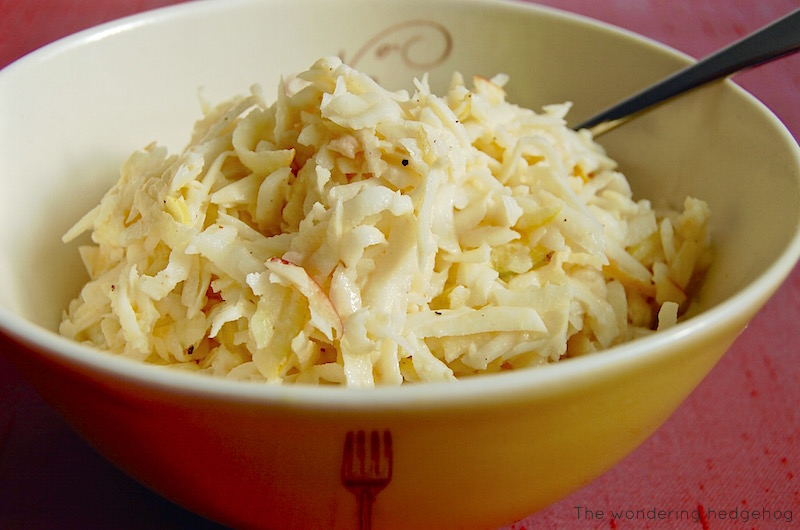| That big, brown, knobby, ugly vegetable known as celery root or celeriac is almost snowy white inside and makes a marvelous salad... |
| ~ Julia Child |
| It seemed to be a sort of monster, or symbol representing a monster, of a form which only a diseased fancy could conceive. If I say that my somewhat extravagant imagination yielded simultaneous pictures of an octopus, a dragon, and a human caricature, I shall not be unfaithful to the spirit of the thing. A pulpy, tentacled head surmounted a grotesque and scaly body with rudimentary wings; but it was the general outline of the whole which made it most shockingly frightful.... The cephalopod head was bent forward, so that the ends of the facial feelers brushed the backs of huge fore paws which clasped the croucher's elevated knees. |
| ~ Howard Phillips Lovecraft, The Call of Cthulhu |
You many be forgiven for thinking, upon your first encounter with celeriac, that you have stumbled upon an excellent Halloween party decoration, instead of something delicious to eat. While there is inarguably something of an Old Great One's appearance to this homely vegetable, looking beneath the surface brings gastronomic rewards.
Contrary to what the name implies, celeriac - or celery root - is not the root portion of the ubiquitous celery stalk bundle, but rather its cousin. Beneath the pebbled and gnarled skin, the flesh is creamy white, with texture similar to that of a cabbage core (or kohlrabi, another underrated vegetable). The flavor is rather difficult to describe, although it is instantly recognizable once tasted - a woodsy, crunchy apple with a touch of parsley and subtle but distinct celery notes.
Celeriac is an incredibly flexible vegetable, delicious both cooked and raw. It can be simply roasted with olive oil, pepper and salt, or thinly sliced and baked into a gratin; it can be boiled and mashed, either alone or mixed with parsnips and potatoes, or pureed into a velvety soup; it can prepared as a salad. It is this last preparation that really highlights celeriac's distinct flavor.
Celery root remoulade is a very common and popular raw preparation in France. The usual mayonnaise dressing is lightened and made more tangy with the addition of crème fraîche, and an apple is incorporated for an unexpected burst of sweetness. For a more traditional remoulade, feel free to omit the apple.
When purchasing celeriac, look for a root that is firm and heavy for its size, and free from any soft spots or blemishes. Orange spots or yellowing on the cut root ends signal the celeriac may be past its prime. Larger roots might be more fibrous and tougher to prepare; smaller roots will be more tender and also offer a brighter flavor.
Celeriac remoulade (celery root salad)
Serves 4 as a side dish
Once the somewhat challenging task of peeling the celeriac is complete, the salad comes together very quickly.
The amount of dressing needed will ultimately depend on how much root is lost in the cleaning process. If you find the salad too dry, simply mix more dressing maintaining the 1:1 mayonnaise:crème fraîche ratio.
In a large bowl, prepare the dressing by mixing together:
- ⅓ Cup mayonnaise
- ⅓ Cup crème fraîche or sour cream
- 1-2 Tablespoons Dijon mustard
- ½ teaspoon kosher salt
- ¼ teaspoon freshly ground black pepper
Wash:
- 1 small celery root, 1 to 1½ lbs / 450 - 700 grams
- 1 crisp eating apple (Braeburn, Granny Smith, Honeycrisp)
Grate the celeriac on the coarsest grater directly into the bowl with prepared dressing. Lightly mix to coat the celeriac with the dressing (this will prevent browning due to oxygenation).
Cut the apple into quarters, and remove the core. Grate the apple on the coarsest grater on top of the celeriac. Mix well to combine. Taste, adjust salt and pepper if needed, and serve.
Celeriac's peak season is late fall and winter, making this recipe a perfect counterpoint to the heavy braises and roasts of the colder months.




